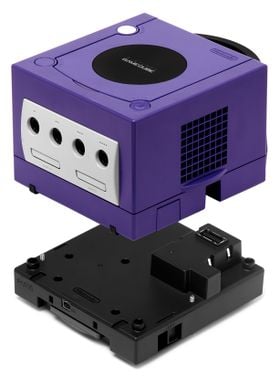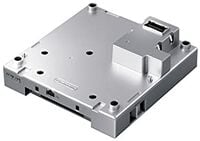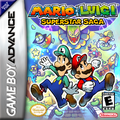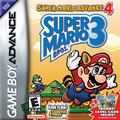Game Boy Player
| Game Boy Player | |
|---|---|
Official logo  A Game Boy Player | |
| Generation | Sixth generation |
| Release dates | |
| Discontinued | 2007[?] |
| Predecessor | Super Game Boy |
| Successors | N/A |
The Game Boy Player is an accessory for the Nintendo GameCube. As the name implies, it can be used for playing Game Boy, Game Boy Color, and Game Boy Advance games. It is the successor to the Super Nintendo Entertainment System's Super Game Boy, which can play only Game Boy games.[note 1]
The Game Boy Player comes with a special start-up disc that must be inserted into the GameCube before any Game Boy games can be played. The Game Boy Player hooks up to the GameCube by being inserted underneath it and fitting into the GameCube's Hi-Speed Port.
As with all models of Game Boy Advance, the Game Boy Player has a Game Link Cable slot on its front that can be used for multiplayer sessions with Game Boy Advance, e-Reader, or other Game Boy Player devices.
All controllers or GBAs connected to the GameCube console are treated as the same player. This makes it impossible to do multiplayer link functions using a single GameCube, but games that make players share a GBA for multiplayer (such as gadgets in Mario Party Advance) can be played more easily.
Controls[edit]
The Game Boy Player can be played with either a standard GameCube controller or a Game Boy Advance hooked with a Nintendo GameCube–Game Boy Advance Link Cable.
Special features in games[edit]
While many GBA games may suffer from intense brightness and/or other minor graphical issues when played on a Game Boy Player, a few games, including two games of the Super Mario franchise (Super Mario Advance 4: Super Mario Bros. 3 and Mario & Luigi: Superstar Saga), are specially optimized for use on the device, with rumble support for GameCube controllers as well. These games are distinguished by showing the Game Boy Player logo upon booting up, regardless of whether or not the device is being used.
In Mario vs. Donkey Kong's "visual options" menu, the "screen" setting can be changed between "GBA Mode" and "GB Player Mode". The latter decreases the overall brightness of the game's visuals, particularly on background elements.
The Game Boy Player has an option to swap cartridges without having to turn off the GameCube, something that is not possible on any Game Boy series device or on the Nintendo DS's Game Boy Advance mode.
Absent features[edit]
For games released on the original Game Boy, the Game Boy Player plays them in Game Boy Color mode and not Super Game Boy mode. As such, the available selectable palettes are those of the Game Boy Color, and the extended color palettes and/or multiplayer supports in Picross 2, Donkey Kong, and Wario Blast: Featuring Bomberman! are unavailable. An exception is the Game Boy Camera, which does carry over the video recording support that it had on the Super Game Boy.
There are a few titles that boot and run normally but are impractical to play on the Game Boy Player, such as WarioWare: Twisted! and Yoshi Topsy-Turvy, because they require the player to rotate the entire system around due to the motion sensors on the cartridge, something that the GameCube was not designed to do.
The Game Boy Player is incompatible with the Wii, as it lacks the Hi-Speed Port of the GameCube where it plugs into. Additionally, the Game Boy Player matches the GameCube's footprint, while the Wii has a different footprint placed horizontally.
Super Mario games with rumble support[edit]
Rumble support in re-releases[edit]
The two games' rumble support was not available on the Wii U's Virtual Console but was restored in Game Boy Advance - Nintendo Classics.
Multimedia[edit]
| File info |
Footnotes[edit]
- ^ Game Boy Color games that have cross-device Game Boy support can also be played on the Super Game Boy.
References[edit]
- ^ Official Mexican Website (Archived). Retrieved November 28, 2022.


